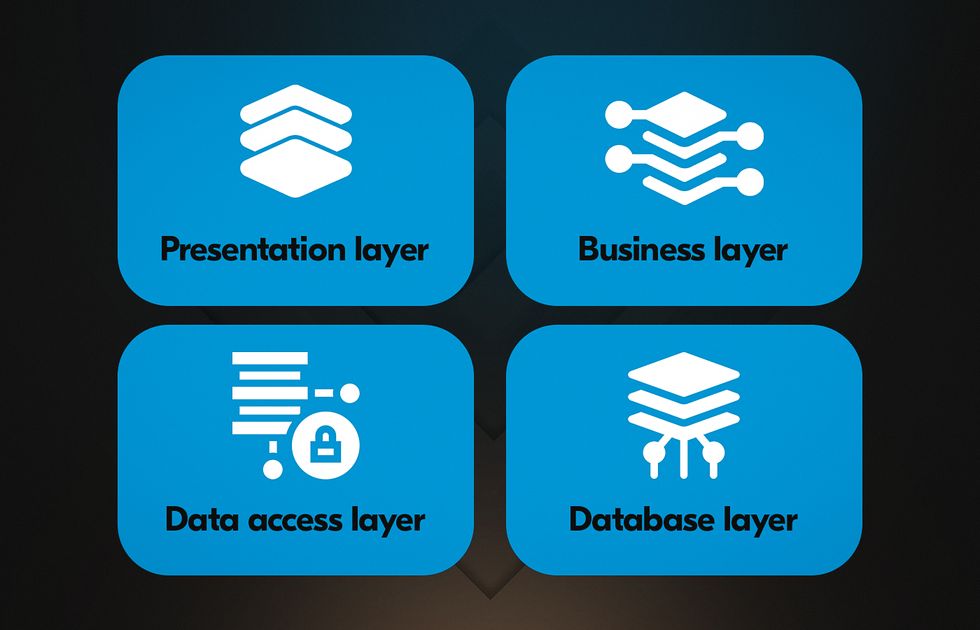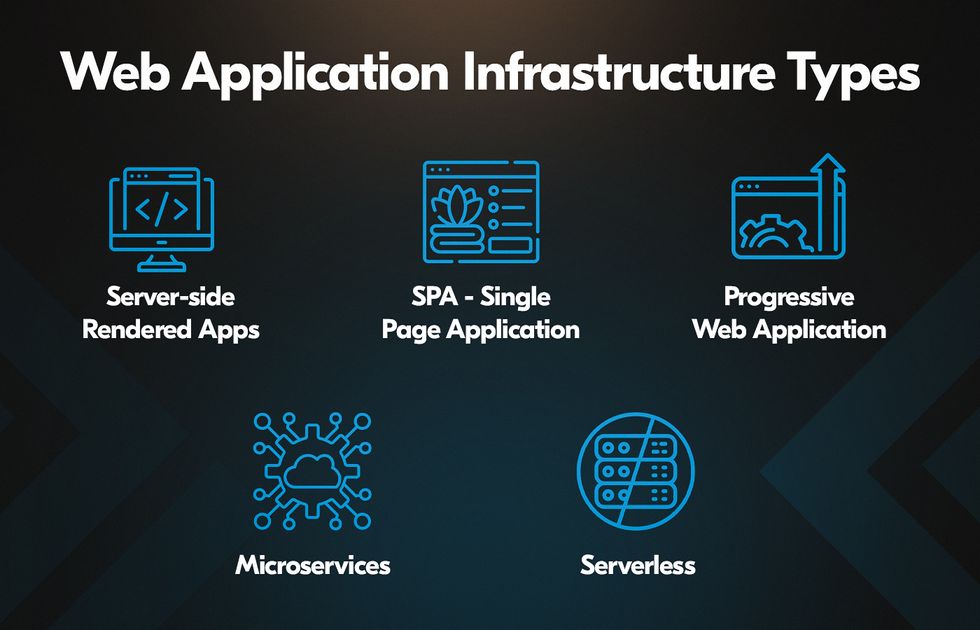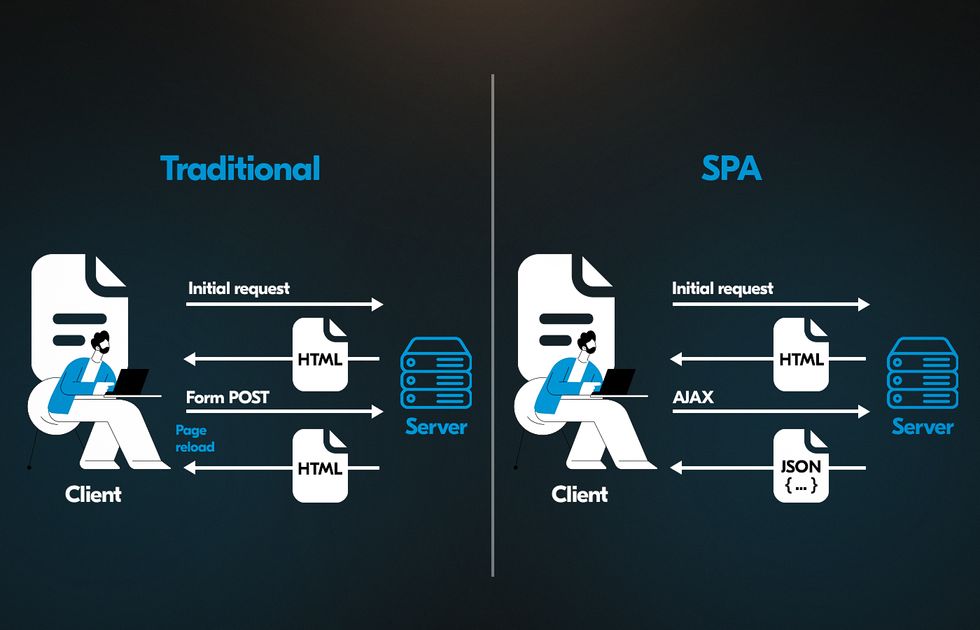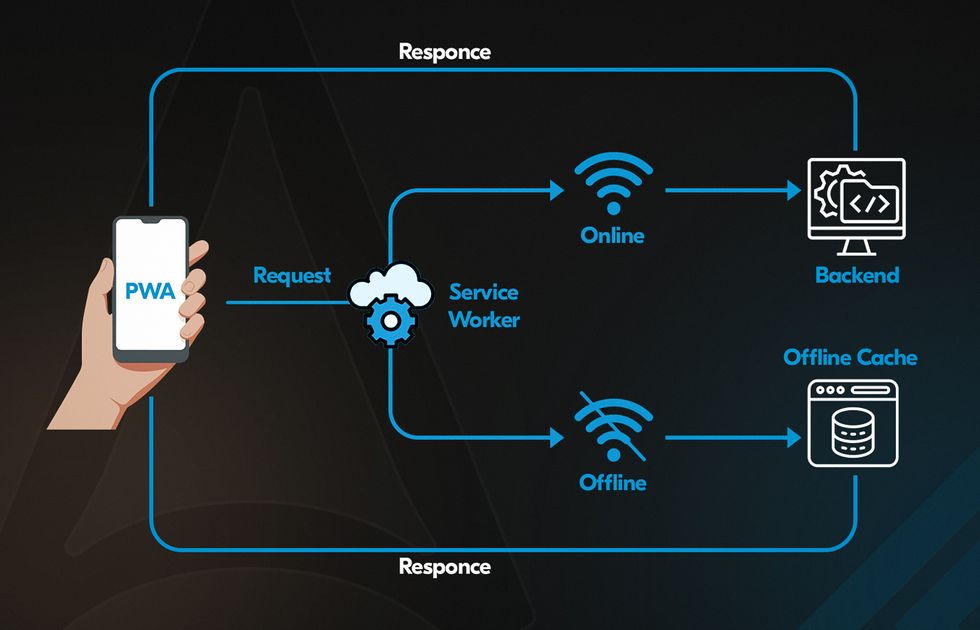

Modern web application architecture is crucial when developing high-performing and scalable solutions. We’ve prepared some recent statistics to prove it.
In this article, we’ll tell you everything the Acropolium team has learned since 2003 about building “unicorn” apps using the right web app architecture. We’ll explain how web applications work and share the best SaaS practices that improve platform performance. So it will be easier for you to make up your mind when hiring a software architect for your startup.
But before that, let’s make sure we’re on the same page.

Web system architecture is a framework for relationships between a web application’s client-side (frontend) and server-side (backend) components. Simply put, architecture outlines how the elements of an app work together.
Let’s take a brief detour to lay out the basic terms. A web application is software accessible through a web browser. Unlike a website (a collection of static pages with text, images, audio, and video), a web app allows users to interact with its elements and manipulate content without reloading the page.
Here are some well-known examples of web apps:
Before discussing how important web app architecture is for development, we should explain what’s under the hood of a web application.

The main components of web portal architecture include a browser, web application server, and database server. Let’s overview each element and see how they impact the system’s performance, scalability, and reliability.
Web UI architecture is a visual presentation of a web app shown in a web browser and allows users to interact with it. It’s rare to find UI as part of the architecture, but it IS a component in modern apps. Why so? Quite often, some parts of the business logic work in the browser via JavaScript.
The content of the web page works through:
The JavaScript layer rests in the user’s browser and communicates with the backend to update the webpage in real time. Modern website architecture models allow the page content to change dynamically as users interact with the interface elements.
Web browsers are the primary interface between end-users and web applications that people run on their devices, such as laptops, smartphones, or tablets. They are written in HTML, CSS, and JavaScript.
Web browsers let users interact with the software by clicking buttons, filling out forms, and navigating through pages. Also, they ensure compatibility across multiple devices and browsers, impact user experience, and play a crucial role in web application security.
Web servers are computers that accept requests, process them, and send the data to the user’s browser.
The term “server” applies to any computer that provides services over the internet (or private network). Servers fall into different categories based on the type of services that run on them. For instance, web servers process HTTP (port 80) and HTTPS (port 443) requests.
These are centralized locations for databases (organized collections of information). Such servers communicate with web ones and provide data to authorized users.

An application server is a program that runs on the server side. It provides a web application’s business logic and functionality by receiving requests from the client side, processing them, and sending back the response.
Application servers improve web app security by enforcing authentication, authorization, and encryption. By distributing the processing load across multiple servers, you can improve app scalability and performance.
The domain name system (DNS) is an internet-based hierarchical naming system that translates a domain name (like www.google.com) into an IP address (8.8.8.8).
Browsers need IP addresses to communicate with web servers. DNS simply helps users connect using readable names instead of complex numbers. You can think of DNS as the contact directory for the internet.
Web applications can consist of multiple services hosted across several servers. Messaging middleware helps different software modules, programming languages, and applications communicate.
The client-side and server-side of the web app interact using synchronous (HTTPS and TCP) protocols. Server-side components of the app could also use asynchronous (AMQP) communication protocol. Besides, middleware software and application programming interfaces (APIs) bridges data between applications and servers.
Every server has limited RAM and CPU, so more user traffic can result in performance issues. Here, load balancers come in handy.
A load balancer processes traffic and distributes it across web servers based on the available computational resources. This optimizes the load, allowing the web app to run smoothly.
The cache is a temporary medium that stores web page data and delivers it faster upon repeated requests.
In the web app server architecture, caching usually happens in the browser. For instance, when you first load a web page, parts of it are saved in your local storage. Then, when you reload the page, the browser gets these files directly from the cache (without contacting the web server).
The content delivery network (CDN) is a server node system that stores and delivers static content (images, audio, videos, CSS, and JavaScript files). CDNs can improve the latency for users who live far away from data centers where your web app is hosted.
Imagine a user from California accessing a web app in a data center in New York. The browser can fetch information from the data center, but the page will take longer to load because of the distance. Now, let’s say a web app utilizes a CDN in California. Then, the browser can download heavy files from a nearby node much faster.
A firewall is a network security system that monitors and controls incoming and outgoing traffic based on predefined rules. It acts as a barrier between the internet and the internal network, preventing unauthorized access and blocking potentially harmful traffic to protect sensitive data.
Compliance with regulatory standards is mandatory in many business sectors, such as finance and healthcare. By enforcing security policies, firewalls can help web applications meet industry-specific requirements.
So, it’s time to tell you how all these components work together when someone interacts with a web app.
Now that you’re familiar with the terms, we can show you what happens when a user enters a URL in the address bar.
All these processes take place on different layers (tiers) of the web application. And this brings us to the next topic.

The infrastructure of a web app includes the presentation, business, data access, and database layers. Here’s what they are responsible for.
The presentation level is the frontend of the web application located in your browser. This tier renders data from the backend into readable content and interface elements.
When a user interacts with a web interface, the presentation layer sends a request to the business layer.
The business layer (application logic tier) is the backend part that determines the internal logic and rules. It contains the application code that coordinates all processes in the app. This tier also transfers the data between the presentation and persistence layers.
This layer interacts with the database to store and retrieve data and operate with it. Besides, it includes the persistence layer, which sends data to the business one upon request.
The database layer comprises a database management system (DBMS) and its actual storage. Consider its design and implementation to ensure the application is fast, reliable, and secure.
Here’s how the layers work together:
At this point, you should already have a clear picture of the whole technology layout. Time to figure out how to choose the architecture for your SaaS MVP.

Every application (web, desktop, or mobile app) has two sides: frontend and backend.
So, we’ll describe the common types of modern architectures separately for the client and server sides of the app.

In the server-side rendered (SSR) architecture, the web server generates the whole page on every request. This means the browser must reload after every time there’s a need to update the page. While it’s great when render times are low, the UX can go south if it takes too long.
The single-page application (SPA) is a modern web application architecture that serves web pages with dynamically updated content. Here’s how the process goes:
The SPA architecture allows the web app to dynamically rewrite the page content without reloading the page. Because of that, the user experience becomes dynamic, and requests become less resource-demanding for the backend.

Progressive web application (PWA) architecture is a hybrid of SPAs and mobile apps. In addition to dynamic JavaScript code, PWAs use:
Service workers connect users to the backend and cache the app data in the background, allowing the web app to be available even offline.

Microservice architecture implies that the app’s backend is split up into multiple single-purpose loosely coupled services. These services run separately, communicate via a network, and scale independently. In addition, microservices communicate synchronously (RESTful API, TCP) or asynchronously (messaging).
For example, an online shop may have microservices for customer registration, file uploading, user interface, product catalog, cart, and payment process.
Here’s what makes the isolated structure of this architecture appealing:
This web development architecture has some drawbacks, though. Resilience testing and monitoring are challenging because you have to work with separate modules across multiple servers. On top of that, your team has to document communications between every microservice.
Serverless architecture is a cloud infrastructure hosted by third-party providers, such as Amazon Web Services (AWS), Microsoft Azure, and Google Cloud.
Serverless solutions can be an alternative or supplement to traditional enterprise web application architecture, boasting several advantages:
The infrastructure security and available resources depend on the third-party vendor, which might concern some enterprises (FinTech and healthcare come to mind). However, you can opt for advanced subscription plans and tenant isolation models with advanced authentication and isolated databases.
Use Backend as a Service as a solution for microservice- and serverless-based web applications. It allows developers to focus on the app frontend and business logic. On the other hand, backend frameworks provide a set of pre-built components and libraries, providing more flexibility and customization options.
You can’t foresee all modern application development problems lying ahead of you. But you can go for some popular approaches that might mitigate them.

Continuous integration (CI) and continuous delivery (CD) emerged to divide web application development into independently managed and delivered components. Simply put, your engineering teams code, test, and integrate the app incrementally.
Companies can use CI/CD to improve integration testing and code stability. For example, you can implement a testable module that compiles and automatically tests code from different developers. Consequently, your team will know about errors and incompatibilities as soon as they happen.
For instance, Netflix uses a CI/CD approach to ensure that new features and updates get deployed quickly and reliably. Their platform Spinnaker handles up to 95% of their daily deployments.
The API-first methodology starts with planning and developing the mockup of an API. Then, after the stakeholders agree on the direction and interface requirements, the rest of the app can be developed in iterations as microservices.
API-first is the opposite of the code-first methodology, where engineers build the API around the code. As a result, the interface in the code-first projects may feel poorly optimized.
Airbnb has implemented an API-first approach to guarantee system modularity and scalability, handling over 100 billion monthly requests.
JAMstack is a dynamic pre-rendering approach based on JavaScript, pre-built hypertext markup, reusable APIs, and CDNs. Here’s how it works.
Your web app is fully rendered in advance and resides on the CDN. Upon user request, the web app is delivered from the CDN to the user’s browser in a timely manner. With JavaScript in a browser, the app can extend its functionality using third-party APIs.
Uber has embraced the JAMstack architecture to build faster, more secure, and more scalable web applications by leveraging static site generators and microservices.
Blockchain is a peer-to-peer ledger of transactions where data is distributed across a network of computers.
The selected participant creates a new block of data containing a hash (a digital fingerprint) of the previous block and a set of transactions. Blockchain networks also use the proof of work mechanism that limits the number of data blocks appearing at given intervals (for example, every ten minutes). To tamper with one block, you must modify the proof of work and hashes for the subsequent blocks.
This creates a data chain that’s nearly impossible to alter undetected. Additionally, you can use a blockchain network to store parts of your data for additional security and resilience.
Walmart has implemented a blockchain-based supply chain management system to ensure its products are safe and high-quality.
Containerization makes your web application portable. This technology is about packaging up the application along with related libraries, configuration files, and supporting dependencies into a single software package (container). The container is independent of the host operating system, allowing it to run on nearly any platform.
Containers make sense if you need a clear plan for designing web application architecture. You may also opt for containerization if you don’t want to tie yourself to a single environment.
Google has built Kubernetes, a container orchestration system to easily deploy, scale, and consistently manage their applications.
Observability is quite troublesome in loosely coupled environments (microservices). You can’t implement an application monitoring tool using only JavaScript to monitor the entire app. But there are turnarounds.
Take AWS X-Ray as an example. It’s a distributed tracing system for microservice applications hosted on its platform. This tool can track, collect, and analyze data for every microservice and its underlying components. In turn, you’ll be able to identify root issues and bottlenecks even with a loosely coupled architecture.
Amazon has implemented a monitoring system called CloudWatch, providing real-time metrics and alerts to quickly identify and resolve any issues.

Acropolium is a web app development company that focuses on your business goals. We enhance existing solutions, develop complex products from scratch, and use low-code solutions to make a project faster and cheaper. In any case, you will receive timely reporting and have the opportunity to influence every stage of development.
Let’s look at examples of our work by overviewing the following BaaS cases:
The architecture of your software mirrors the applications you build. This interpretation of Conway’s law demonstrates the importance of web application architecture during development. So you better take your time to figure out the intricacies of your chosen approach.
And if it’s not something you want to get too involved with, hire a software development vendor who knows web based architecture inside-out.
Acropolium is eager to help you out with our industry-specific knowledge and dedicated team of vetted engineers, architects, and project managers. Together, we can transform your ideas into a feature-rich, secure, and high-performing app. Drop us a line to learn more.